Hausmann Quartet Pairs John Cage and Caroline Shaw with Haydn and Beethoven
Caroline Shaw, the young, New York City based contemporary composer, has acquired a serious following here in San Diego County. In 2013—the year after she won the coveted Pulitzer Prize in Music—she was featured as composer-in-residence at the Carlsbad Music Festival, and this summer she fulfilled a similar role at the La Jolla SummerFest.
On Sunday’s Hausmann Quartet concert at the Maritime Museum of San Diego, the intrepid quartet played Shaw’s 2016 piece “Blueprint,” paired with Beethoven’s B-flat major Quartet, Op. 18, No. 6, the work on which Shaw based her single-movement string quartet. According to the composer’s notes for “Blueprint,” her composition “began its life as a harmonic reduction — a kind of floor plan — of Beethoven’s String Quartet, Op. 18, No. 6.” To be sure, the styles of these two pieces could hardly be more distinct. While Beethoven organizes his quartet in the the traditional four movement format, where each movement presents a contrasting mood and tempo, and consistently creates a rich texture comprised of long, contiguous lines, Shaw has compressed her quartet into a single movement in which mood and tempo change quickly—even abruptly—and her airy textures abound in terse motifs separated by plentiful rests. For example, Beethoven’s elegant violin traceries in his hushed second movement, executed with finesse by Isaac Allen and Bram Goldstein, are as distant from Shaw’s aggressive pizzicato attacks, especially from cellist Alex Greenbaum, as any serious chamber music aficionado expects to experience in a single concert.No doubt all of the music theory teachers in the audience were closely following Shaw’s “harmonic reduction” of the Beethoven, but I daresay that most of Sunday’s audience was more impressed by the expected three-century stylistic contrast between the two composers. Perhaps we sensed a vague compatibility of these two works, but there was significantly more stylistic connection between the Beethoven Op 18, No. 6, and Hausmann’s program-opening performance of Joseph Haydn’s D Major Quartet, Op. 72, No. 2, a work composed the same year young Beethoven was studying music theory under Papa Haydn’s tutelage.
Hausmann calls its concert series at the Maritime Museum the Haydn Voyages, which means that every concert presents at least one Haydn string quartet as the ensemble slowly works its way through the extensive Haydn canon. Hausmann’s confidence with the composer’s style focused quite early in the their series at the Maritime Museum, which makes each Haydn offering a kind of welcome homecoming. In Hausmann’s electric yet lucidly balanced account of the D Major Quartet, Op. 72, No. 2, Sunday’s audience found the vivacious themes and ebullient figurations irresistible, no doubt the similar reaction of the noble patrons who eagerly commissioned Haydn’s chamber works.
More radical than Shaw’s recent quartet, John Cage’s “Four” from 1989 treated the audience to what resident musicologist Derek Katz called “enlightened anarchy,” an exercise of broadly calculated chance that assures no two performances of “Four” will ever sound the same. In Hausmann’s interpretation of the composer’s possibilities, we heard hushed, sustained, slowly changing clusters that favored close intervals, a suspense inducing sonic cloud that quickly lowered the room’s ambient sounds. Only the gentlest of pizzicato strokes from violist Angela Choong and violinist Allen midway through the performance challenged Cage’s uniform character
But in an all too perfect Cage appropriate moment, through the open windows of the bayside museum, the sounds of recorded pop music from a large boat sailing by impinged and then receded on Hausmann’s sound cloud. I cannot help but imagine that the composer of 4’ 33” would have been pleased—or at least amused.

Ken Herman, a classically trained pianist and organist, has covered music for the San Diego Union, the Los Angeles Times’ San Diego Edition, and for sandiego.com. He has won numerous awards, including first place for Live Performance and Opera Reviews in the 2017, the 2018, and the 2019 Excellence in Journalism Awards competition held by the San Diego Press Club. A Chicago native, he came to San Diego to pursue a graduate degree and stayed.Read more…


